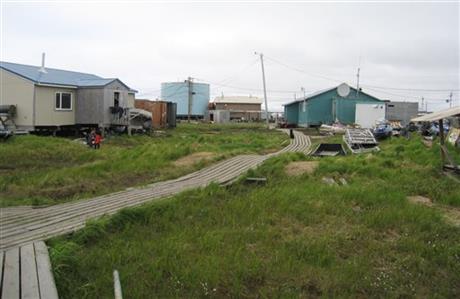
In this 2006 photo provided by the State of Alaska Department of Commerce, wooden boards connect houses in Newtok, Alaska. The flood-prone village of Newtok near Alaska’s storm-battered coast is running out of time as coastal erosion creeps ever closer to the Yup’ik Eskimo community. As residents wait for a new village to be built on higher ground nine miles away, a dispute over who is in charge has led to a rare intervention by the Bureau of Indian Affairs, which ruled that the sitting tribal council no longer represents the community of 350 as far as the agency is concerned. (AP Photo/State of Alaska)
Eroding Village
In this 2006 photo provided by the State of Alaska Department of Commerce, a post office in Newtok, Alaska is shown. The flood-prone village of Newtok near Alaska’s storm-battered coast is running out of time as coastal erosion creeps ever closer to the Yup’ik Eskimo community. As residents wait for a new village to be built on higher ground nine miles away, a dispute over who is in charge has led to a rare intervention by the Bureau of Indian Affairs, which ruled that the sitting tribal council no longer represents the community of 350 as far as the agency is concerned. (AP Photo/State of Alaska)
Prev
1 of 2
Next
ANCHORAGE, Alaska (AP) — The flood-prone village of Newtok near Alaska’s storm-battered coast is running out of time as coastal erosion creeps ever closer to the Yup’ik Eskimo community.
As residents wait for a new village to be built on higher ground nine miles away, a dispute over who is in charge has led to a rare intervention by the Bureau of Indian Affairs, which ruled that the sitting tribal council no longer represents the community of 350 as far as the agency is concerned.
Council leaders are appealing the BIA’s decision, which gave the funding-administrative power to a new group that claims it is the rightfully elected council.
Until the matter is resolved, millions of dollars in government funds for the relocation effort have been halted, as nature’s relentless erosion continues, oblivious to who is in charge.
“Who’s suffering here is the community members,” said Scott Ruby, director of the state agency that administers the relocation grants.
Newtok is one of Alaska’s most eroded coastal villages and the only one that has begun a physical move, with the raging Ninglick River steadily inching toward homes. Officials estimate Newtok, 480 miles west of Anchorage, has until the end of the decade before erosion causes severe damage.
Government funds have been used over the last seven years to build six homes, a barge landing, roads and five storage structures at the site of the new village. Now those structures sit as reminders that a community’s dreams of a rebirth are still unrealized.
“We’re just falling way back,” said Stanley Tom, a longtime tribal administrator who is part of the group whose authority is no longer recognized.
In its ruling, the BIA said required elections were purportedly not held for more than seven years, so the old council had been operating on expired terms. The old council denies the allegations.
The new council members were first elected in October 2012. The following month, members of the old council held another election. The resulting dispute reached a boiling point in June when the new council got more votes during a community meeting attended by both sides.
That victory carried significant weight in the BIA’s decision, which said its decision applies to such purposes as bureau funding.
Members of the new council have not responded to requests from The Associated Press for comment.
The state, which is not bound by the BIA decision, has been sitting on $6.5 million in reimbursable grant funds for the relocation effort, including proceeding with building out an evacuation center at the new location called Mertarvik.
Any payout has been delayed by the dispute and failure of the new faction to establish an official bank account until recently. The state expects to soon issue $51,000 in revenue sharing funds to the new council that should have been distributed last summer.
Relocations funds probably won’t be disbursed until next spring at the earliest.
Adding to the complication, recent audits by the state concluded that the old faction mismanaged the administration of other relocation grants, such as changing the architectural design of the evacuation center after it took over the project from the state in 2011.
The audit also noted apparent payroll improprieties, including exorbitant compensation for certain employees. The audit recommends that the tribe return about $300,000 to the state for alleged improprieties including duplicate payments on invoices and retroactive wages for employees.
Officials have denied any mismanagement.
At the same time, members of the new council failed to hold a required election last month, saying they wanted to wait until the dispute was resolved, according to Ruby of the state Division of Commerce, Community and Economic Development.
He would have liked to have seen an election held so that anyone who wanted to run, including members of the old faction, could have done so. He said the issue will have to be revisited later.
For now, there is no time to waste, so the state is recognizing the new council, Ruby said. The Ninglick River is swallowing more and more bank each year just south of the village. Sinking permafrost continues to subject the area to flooding from intensifying storms blamed on climate change.
“There’s a real need out there,” he said.



